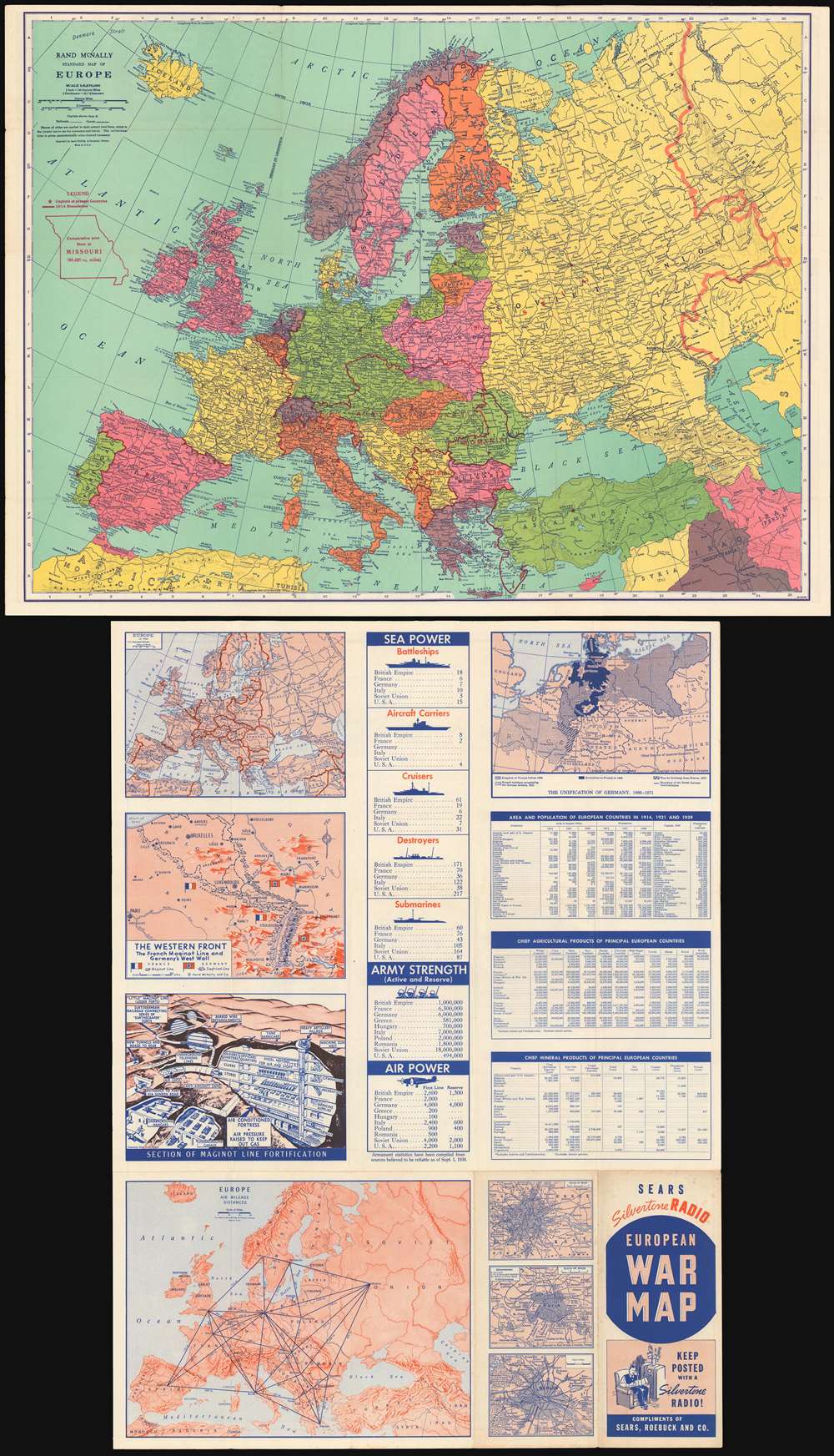
This item below is out of stock, but another example (left) is available. To view the available item, click "Details."
Details
1939 Sears and Roebuck Map of the Predicted Theatre of World War II
$175.00
1939 Sears and Roebuck Map of the Predicted Theatre of World War Two
SilvertoneWar-randmcnally-1939
Title
1940 (dated 1939) 18.75 x 24.75 in (47.625 x 62.865 cm) 1 : 8870000
Description
The Verso
This is a compendium of recent European history, and contemporary statistics. There are four maps: one shows the post-Versailles borders of Europe as of 1921; another details the process of the 19th century unification of Germany - reinforcing the idea that the upcoming war was just another in an inevitable series with a historical foe. In keeping with this retrospective view, a detailed map of the Western Front marks the heavily fortified border between France and Germany: the Siegfried Line and the Maginot Line, both shown pictorially with pillboxes facing off against each other toe-to-toe - until the lines separate at Belgium and Luxembourg. (A fourth map marks the distances, by air, between major European cities - one of the few acknowledgements here that the next war might be different from the last.) There is a detailed, largely imaginary, and tragically optimistic cut-away diagram of the apparently impregnable fortifications of the Maginot line, linked by subways and offering its soldiery all the comforts of a modern city while they defend France against any German foe willing to make a frontal assault against its emplacements. There are city plans of London, Paris and Berlin - again, suggesting that no other major players might exist in the coming war.The Numbers
Statistics of national arms and populations compare sea power, army strength, and air power - with the United States trailing in most categories. Three tables compare land mass, population changes since 1914, and chief mineral productions among the European nations. The implication throughout is that the United States - though able to protect itself with a strong navy and air force - would be well advised to avoid committing land forces to what would surely be a European affair. Japan, of course, is mentioned nowhere.Publication History
We have identified only a single state of this map, and it appears to have been produced in a single edition. It is neglected by institutional collections: OCLC has a single copy at UCLA. The vigilant collector will find examples of this map, but it has evaded dealers' catalogues and it does not appear in auction records.Cartographer
Rand, McNally and Co. (fl. 1856 - present) is an American publisher of maps, atlases and globes. The company was founded in 1856 when William H. Rand, a native of Quincy, Massachusetts, opened a print shop in Chicago. Rand hired the recent Irish immigrant Andrew McNally to assist in the shop giving him a wage of 9 USD per week. The duo landed several important contracts, including the Tribune's (later renamed the Chicago Tribune) printing operation. In 1872, Rand McNally produced its first map, a railroad guide, using a new cost effective printing technique known as wax process engraving. As Chicago developed as a railway hub, the Rand firm, now incorporated as Rand McNally, began producing a wide array of railroad maps and guides. Over time, the firm expanded into atlases, globes, educational material, and general literature. By embracing the wax engraving process, Rand McNally was able to dominate the map and atlas market, pushing more traditional American lithographic publishers like Colton, Johnson, and Mitchell out of business. Eventually Rand McNally opened an annex office in New York City headed by Caleb S. Hammond, whose name is today synonymous with maps and atlases, and who later started his own map company, C. S. Hammond & Co. Both firms remain in business. More by this mapmaker...

